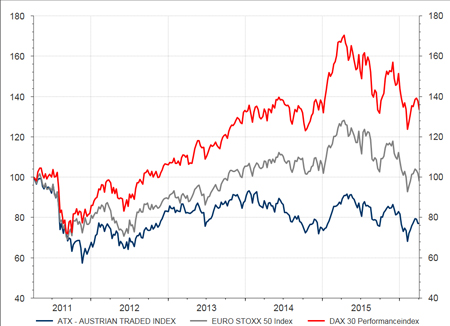
The Austrian economy grew by a total of +0.9% (2014: +0.4%) in 2015. Quarterly growth improved drastically on a year-on-year basis from Q2 onwards. From Q1 to Q4 2015, GDP posted growth rates of +0.5%, +0.9%, +1.0%, and +1.1%, respectively. Growth was supported in particular by the upturn of investment, private consumption, and foreign trade. In the fourth quarter, the contribution from public consumption was particularly strong due to the spending on refugees.
The survey results of the economic test run by the Austrian Institute of Economic Research (WIFO) in March indicate a stable assessment of the economic climate. While the assessment of the economic status quo by Austrian companies has improved on the previous month, the outlook for the coming months has deteriorated slightly.
The Research department of Erste Group expects the upswing in the Austrian business sector to continue in 2016 and 2017, with real economic growth rates of +1.7% per year. The growth expectation is based on sustainably strong domestic demand that is also supported by the tax reform and government spending. This and the low interest rate should also facilitate a further recovery of investment. However, the downside risks of this forecast are still in place.
| 2015 | 2016f | 2017f | |
|---|---|---|---|
| Real GDP % | 0.9 | 1.7 | 1.7 |
| Inflation | 0.8 | 1.2 | 1.8 |
| Unemployment rate | 5.7 | 6.1 | 6.2 |
| Budget deficit % GDP | -1.2 | -1.4 | -1.3 |
| Government debt in % of GDP | 86.2 | 85.1 | 84.1 |
Sources: Statistik Austria, BMF, Erste Group Research
Austria’s competitiveness in decline
Even though the Austrian economy has recovered a bit, it still fails to measure up to international comparison. According to a study from Erste Group, Austria was outgrowing the Eurozone average from 2002 to 2013 (while beating Germany in 2002 to 2009); but in 2014, this trend was interrupted. For the past two years, Austrian GDP growth has been below average. Wealth as measured by GDP per capita has also fallen: in 2012, Austria was the second-wealthiest country in the EU, but it had fallen to sixth place by 2014.
According to a study by the European Commission , the slow-down of potential growth in Austria can be explained by falling labour productivity. Since 2011, productivity figures have fallen short of those for Germany and the Eurozone due to rising prices. Thus inflation in Austria has exceeded referential figures of other countries drastically. The price rises have internal causes such as higher taxes and duties. These factors play a crucial role in the loss of competitiveness. Looking ahead, the tax reform might stimulate private consumption by a minor degree. Overall the expected growth rates remain relatively subdued.
Interest rates remain low
After the further loosening of the monetary policy announced by the European Central Bank on 10 March 2016 the outlook for interest rates and yields remains unchanged. Money market rates remain close to zero percent, and the yields of Austrian government bonds are close to their all-time low. The spreads of Austrian government bonds relative to 10Y German government bonds had temporarily widened at the beginning of February in the wake of the announcement of the Heta buy-back offer. After the offer had collapsed on 11 March, the spreads fell back to the long-term level of about 20bps.
Equity markets remain volatile
While the ATX as main index of the Vienna stock exchange has outperformed the German equity index on a year-on-year basis, it is currently on clearly negative terrain, much like the EURO STOXX 50 index. However, in a long-term analysis, we find that both DAX and EURO STOXX 50 have clearly come out on top vis-à-vis the ATX. In an optimistic wording, one could argue that the shares on the Vienna stock exchange have a lot of catch-up potential going for themselves.
For the time being, equities will remain highly volatile. The expected rate hike cycle in the USA and the uncertain outlook for the global economy will be omnipresent this year. That being said, equities should generally find support in the low-interest-rate policy of the Eurozone and in investors’ search for yield.
Performance comparison ATX-Index, DAX-Index and EURO STOXX 50-Index (- 5 years; as of 5.4.2016)

Author:
Paul Severin
Head of Communications Erste Asset Management
Member of the board of OVFA
6 April 2016
Note
Wiener Börse AG would explicitly like to point out that the data and calculations given in this report are historic values, which do not permit any conclusions as regards future developments or value stability. Price fluctuations and loss of capital are possible in securities trading. The contribution is the personal opinion of the analyst and does not constitute a financial analysis or a recommendation for investment by the exchange operating company, Wiener Börse AG.

![Erste Asset Management [Translate to English:] Erste Asset Management](/uploads/u/cms/images/logos/emittenten/analysen/erste-asset-management-logo.gif)